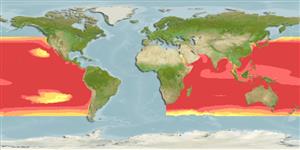分類 / Names
共通名の | 類義語 | Catalog of Fishes(部類, 種) | ITIS | CoL | WoRMS | Cloffa
Environment: milieu / climate zone / depth range / distribution range
生態学
海; 海洋回遊性 (Ref. 51243); 深さの範囲 0 - 200 m (Ref. 43). Subtropical; 20°C - 25°C (Ref. 54918); 46°N - 49°S, 19°E - 69°W (Ref. 54918)
Indo-Pacific: tropical, subtropical and temperate waters. Highly migratory species.
The distribution in the Pacific Ocean is unique among billfishes and tunas in that it forms a horseshoe-shaped pattern from the northwest Pacific through the eastern Pacific to the southwest Pacific (Ref. 30443). In the Indian Ocean, fish are more densely distributed in equatorial regions with higher concentrations off eastern Africa, in the western Arabian Sea, the Bay of Bengal and off northwestern Australia (Ref. 30444).
Length at first maturity / サイズ / 重さ / 年齢
Maturity: Lm 210.0, range 190 - ? cm
Max length : 420 cm TL オス/雌雄の選別がない; (Ref. 30874); common length : 290 cm TL オス/雌雄の選別がない; (Ref. 9308); 最大公表体重: 440.0 kg (Ref. 30874)
背面の脊椎 (合計): 0; 背鰭 (合計): 42-48; 肛門の骨 0; 臀鰭: 18 - 24. Body elongated and compressed; upper jaw produced into a robust and medium sized beak; two dorsal fins, the height of the first greater than the greatest depth, short anteriorly, taller in the middle, then becoming shorter posteriorly; pectoral fins falcate and flexible, with 18 to 22 rays; body densely covered by small, embedded scales with 1 or 2 bluntish points; back dark blue; belly silvery; membrane of first dorsal fin blue black without dark spots; flanks with about 20 bluish stripes (Ref. 55763). Blue-black above and silvery white below, with about 15 rows of cobalt-colored stripes; 1st dorsal fin dark blue; other fins dark brown, sometimes with a tinge of dark blue; anal fin bases with a tinge of silvery white.
Epipelagic and oceanic species, usually found above the thermocline. Generally inhabit cooler water than either black (Makaira indica) or blue marlin (M. mazara) (Ref. 43). Most dominant and widely distributed of all billfishes. Their abundance increases with distance from the continental shelf (Ref. 6390). Usually seen close to shore only where deep drop-offs occur (Ref. 6390). Mostly solitary, but form small schools by size during the spawning season (Ref. 9987). They are usually dispersed at considerably wide distances. Feed on fishes, crustaceans and squids. Also caught with the harpoon. The flesh is the best among billfishes for sashimi and sushi. Marketed mostly frozen, sometimes fresh (Ref. 43); also smoked and frozen (Ref. 9987). Also Ref. 9137, 9574.
Life cycle and mating behavior
成熟 | 繁殖 | 放精 | 卵 | 生産力 | 幼生
Females are indeterminate batch spawners with asynchronous oocyte development (Ref. 92477). Larvae are most abundant in the respective local early summers. The seasonal occurrence of mature females coincides with that of the larvae. The lower temperature limit in the distribution of larvae is approximately 24°C, both in the Indian and Pacific Oceans.
Spawning sites are between 10°S and 30°S in Southwest Pacific and 10°S and 20°S in northeastern Indian Ocean (Ref. 6390).
Nakamura, I., 1985. FAO species catalogue. Vol. 5. Billfishes of the world. An annotated and illustrated catalogue of marlins, sailfishes, spearfishes and swordfishes known to date. FAO Fish. Synop. 125(5):65p. Rome: FAO. (Ref. 43)
Human uses
水産業: 商業; ゲームフィッシュ: はい
より多くの情報
参考文献水産養殖水産養殖の紹介緊張遺伝子のElectrophoreses遺伝病気行列NutrientsMass conversion
用具
特記事項
XMLをダウンロードして下さい
インターネットの情報源
Estimates based on models
Preferred temperature (Ref.
123201): 14.6 - 28.3, mean 25.9 °C (based on 1534 cells).
Phylogenetic diversity index (Ref.
82804): PD
50 = 0.7505 [Uniqueness, from 0.5 = low to 2.0 = high].
Bayesian length-weight: a=0.00550 (0.00297 - 0.01015), b=3.15 (2.98 - 3.32), in cm total length, based on LWR estimates for this species & (Sub)family-body (Ref.
93245).
栄養段階 (Ref.
69278): 4.5 ±0.73 se; based on food items.
Generation time: 2.5 (1.5 - 5.0) years. Estimated as median ln(3)/K based on 13
growth studies.
回復力 (Ref.
120179): 手段, 1.4年~4.4年の倍増期間の最小個体群 (K=0.2-0.6; tm=2-3; Fec=90-281 million (annual reproductive output)).
Prior r = 0.22, 95% CL = 0.12 - 0.40, Based on 1 stock assessment.
Fishing Vulnerability (Ref.
59153): Moderate vulnerability (44 of 100).
Climate Vulnerability (Ref.
125649): Moderate to high vulnerability (48 of 100).
Nutrients (Ref.
124155): Calcium = 29.3 [12.2, 54.6] mg/100g; Iron = 0.97 [0.53, 1.79] mg/100g; Protein = 19.9 [18.6, 21.0] %; Omega3 = 0.217 [0.110, 0.427] g/100g; Selenium = 50.6 [25.2, 110.9] μg/100g; VitaminA = 3.89 [1.10, 13.77] μg/100g; Zinc = 0.31 [0.20, 0.48] mg/100g (wet weight);
